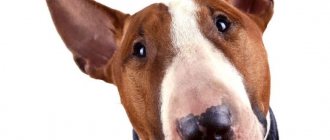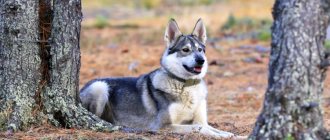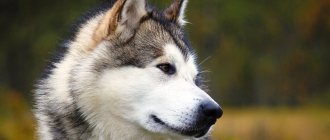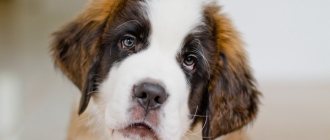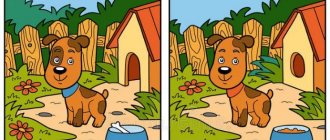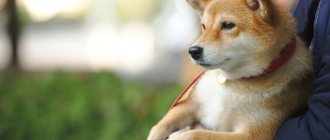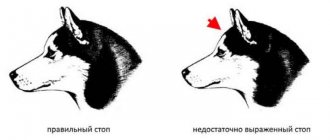What do huskies look like?
The ancestors of modern dogs were bred in Northeast Asia, where they were used by nomadic tribes as sled dogs. During the gold rush they were brought to Alaska. There, sled dogs eventually gained popularity. It was the huskies who took part in the Great Race of Mercy and helped deliver diphtheria serum to the city of Nome, which was actually on the verge of death.
Photo: HannaNes/Depositphotos
The Siberian Husky is a medium-sized dog with a well-proportioned, muscular body. The back, lower back and chest are strong, the stomach is slightly tucked. The ears are erect, triangular and slightly rounded at the ends, located high on the head, at a short distance from each other. The tail is well feathered, when raised it is shaped like a sickle and does not curl into a ring; when lowered it is straight.
The Husky's coat is of medium length, with a soft, dense undercoat and smooth, straight, not too hard guard hair. There are different colors, including black, white, black and white, gray, red, agouti and others. Huskies have brown and blue eyes, although there are also dogs with heterochromia - when the iris is of different colors.
What is the difference between a husky and a malamute?
How often on the street people confuse these two breeds, and the owners get tired of explaining that they have a husky on a leash, and not a malamute.
The Siberian Husky is significantly smaller in size. They are lighter and more elegant. Their fur is shorter, softer and does not stick out in different directions, like Malamutes. Unlike huskies, malamutes have blue eyes, which is a disqualifying fault.
And one more difference is the tail. Malamutes have it more fluffy; when moving, they hold it above their back, and when calm, they place it on it.
We can talk endlessly about the characteristics of the breed, fortunately, there is enough information. These are kind, active, amazing creatures. It is not for nothing that under the monument to the famous Balto there is an inscription engraved - endurance, devotion, intelligence. This is the best formulation that widely reveals the essence of the Siberian Husky.
What is the character of a husky?
Dogs of this Siberian Husky breed are friendly and affectionate, active, mischievous and restless. Huskies love to be on the move, and their ebullient energy needs a constant outlet.
How do huskies get along with adults?
Sociable dogs become attached to all family members and treat everyone with respect. These animals feel great in human society and do not like to be left unattended for a long time.
Huskies do not show aggression towards people they do not know. So the dog will bestow its attention even on guests and will not try to avoid their company. But these dogs do not make very good guards - due to their natural friendliness and almost complete lack of aggression.
How do huskies get along with children?
Sociable animals get along well with younger family members and show kindness towards them. However, children and puppies should not be left alone unattended. Active, energetic and playful Huskies can accidentally push a child, although they do not want to harm him at all.
How do huskies get along with other animals?
Representatives of this breed usually do not conflict with other dogs. With other pets, things are more complicated: the husky has quite strong hunting instincts. The Siberian Husky. And they can perceive rabbits, guinea pigs, hamsters, birds and even cats as potential prey, although they can also have neutral relationships with the latter.
How hard is it to train?
Difficulties in training arise with any dog, the husky is no exception. Representatives of the breed, as written above, are stubborn, they require increased attention when practicing commands. The owner, when training a dog, has no right to make a mistake, because it is impossible to correct it on his own without experience in behavior correction.
The Husky is a working dog and requires a completely different approach to training than a working dog. Husky training begins at three months of age; until then, the puppy is raised without the use of physical force or raising his voice.
Golden rules that must be followed by the owner:
- Husky puppies make you want to show tenderness, pet them once again, hug and cuddle, lisping at the same time. The pet should receive affection in portions, as a reward. Hugs and lamentations will let the puppy understand that the owner is weak-willed; he can sit on his neck and not obey.
- Consistency in education and training is key. A ban on something must be permanent, as well as permission for a particular action. For example, a puppy wants to climb onto the sofa, but the owner forbids it. The next day, the pet again tries to climb onto the sofa, the owner smiles and allows it. This should not happen, because the puppy will refuse to understand the inconsistent owner in the future.
- Huskies require respectful treatment. Yelling at a small pet is prohibited, as is yelling at an adult dog.
- Representatives of the breed are smart, but very independent and are able to make decisions without regard to the owner’s opinion. You should not allow your dog to think about whether to follow the command or not. Commands are carried out without fail, without any hesitation. Read about the smartest dog breeds.
- Training begins with play; huskies cannot stand routine; activities should arouse their interest. An assistant in this matter will be a toy that motivates the dog.
What living conditions are required for huskies?
When a puppy arrives in the house, give him his own place with a bed or mattress where he will rest and feel safe.
Puppies will really like different balls and other toys with which they can have fun. Otherwise, they can chew off everything that falls into their mouth. Huskies also have one more “hobby” that may not appeal to everyone. Many dogs of this breed love to dig. They are not averse to rummaging even in flower beds and beds or digging into a neighboring plot, and in search of adventure they can easily jump over a low fence.
Particular attention should be paid to the physical form of The Siberian Husky animals. Huskies are active, full of energy dogs that will not be comfortable within the four walls of an apartment without active walks and training. Constant and intense physical activity, performed under human supervision, will help the dog stay in good shape and strengthen its bond with its owner.
Photo: skvortsova/Depositphotos
The dogs are also enthusiastic about sledding. The disciplines in such competitions are different. Among the traditional winter ones are classic sled races over distances of different lengths, as well as skipuling and skijoring. Snowless competitions (dryland) are also held. So, in canicross, huskies pull a running athlete behind them, and during bike joring, the animals move in conjunction with the cyclist.
Characteristics of the Siberian Husky: education and training
The Siberian Husky is a breed with a wayward character, which is sometimes difficult to cope with. Improper upbringing leads to disobedience, sometimes to difficulties in living together.
It is difficult for an inexperienced dog breeder to train at home. First you have to learn the basics, take into account breed and individual characteristics.
The learning process and communication are the basis for building contact between pet and owner.
In our article we will talk not only about training and education, but we will touch on the history of origin, standards in general terms, as well as the topic of health.
How to feed a husky
Decide on your pet's diet right away. The simplest option is ready-made complete food, presented in the lines of well-known manufacturers. It is better to give preference to high-quality products that contain all the beneficial substances and nutrients that animals need. You can choose either a universal or a special diet for dogs with various diseases, including food allergies.
Another option is natural food that you prepare for your pet yourself. The basis of such a diet should be meat: beef, veal, rabbit, poultry. Offal, fish, vegetables, and cereals in small quantities are also possible.
It is better not to offer the leftovers of your lunch or dinner to your animal. Spicy, salty, sweet, smoked and spicy foods are harmful to him.
When buying a puppy, be sure to find out what it was fed. At first, give him only his usual food, otherwise he may have difficulties with digestion or he will simply refuse food. Over time, the diet can be changed, but this must be done gradually so that problems do not arise.
Make sure that your husky always has a bowl of clean drinking water.
Handling for Husky
Handling is the art of showing dogs at shows. The handler’s job is to competently show the Husky to the expert in the ring, to demonstrate all its advantages. Preparing the dog for ring work is also part of the handler’s duties.
Our specialist can show your dog in the rings at shows himself, or teach you how to show it correctly.
Preparation for the exhibition
- Training in correct breed show stance
- Training in endurance and concentration
- Developing a calm reaction to the close presence of other dogs
- Calm behavior during a tactile examination of a dog by an expert
- Showing the bite and complete dental system
- Learning the correct movements in the ring.
How to care for a husky
Brushing the coat of dogs of this breed is enough once a week, so caring for the Siberian Husky is not particularly difficult. During molting periods, which usually occur in spring and autumn, it is advisable to carry out this procedure daily. Huskies do not have the characteristic “dog” smell.
Photo: Westsib/Depositphotos
These animals do not need frequent bathing. It is enough to give them a bath day several times a year. The exception is pets that participate in exhibitions. Also, an unscheduled bath may be necessary if the husky is very dirty and there is simply no other way to clean his fur. In this case, you need to use only special products that are sold in pet stores.
Special attention is required to the length of the dog's claws. They are trimmed as they grow, and this can be done either independently or by specialists.
Siberian Husky: description of the breed and character
Now let’s talk in more detail about character traits, health and upbringing.
Aggressiveness
Nature dictates that the Siberian Husky is not aggressive towards people and animals. They are unable to distinguish a person who has a negative attitude. This makes them bad guards, but on the other hand, their purpose is not to protect at all.
If a husky is showing aggressiveness, then you should look deeper. Perhaps the owner missed certain points in upbringing or unscrupulous breeders do not take breeding seriously. Such dogs should not be used in the future as breeders. In the show ring, an expert disqualifies a dog for showing aggression.
Activity
This breed is absolutely not suitable for lazy people. The owner must be an energetic, active person in order to provide the dog with proper physical activity. There will be long active walks, during which you should pay attention to training points.
You should not let your dog off the leash, even in a deserted place. Siberian Huskies love freedom, despite their attachment to the owner, they can run away wherever they look. That’s why you can often find missing husky ads on websites.
Particular attention to active physical activity should be given to dogs living in apartment conditions. If they don’t spend energy outside, then at home you will find chewed furniture, ruined shoes and a lot of other interesting things.
Training and education
When a puppy appears in the house, it immediately begins to test the owners’ strength of character. If he comes across your weaknesses, he will begin to put pressure on them. Then education and further training will become more difficult.
It is better not for beginners to train on their own. To avoid a lot of mistakes, contact experienced instructors. They will help you choose the appropriate training method for your dog.
Initially, it is necessary to teach your pet commands that will make living together comfortable. Start teaching your four-legged friend to toilet outside.
The training time depends on the age of the pet. You can’t demand that a small puppy follow commands for half a day. Soon he will get bored, and next time he will not want to engage with the owner at all. Therefore, it is very important to interest the dog and not overwhelm it. The optimal practice time is 15-20 minutes a day.
Training a dog is similar to raising children. There must be punishment and reward. It is categorically impossible to punish physically, but it is easy to ignore. The dog is very sensitive to the displeasure of its beloved owner. If your pet demonstrates the desired behavior, praise him loudly and give him a toy or treat. Having realized that the owner is happy, next time the command will be carried out even better.
Need for care
The Siberian Husky is a dream for those who want to keep a dog in apartment conditions. These are the owners of self-cleaning wool, which means there is practically no specific dog smell. No special care is required for the coat, other than brushing during the molting period.
Ears need to be cleaned and examined a couple of times a week. The claws of huskies leading an active lifestyle should be worn down on their own.
Friendliness and attitude towards children
Even at the stage of the birth of the breed, northern residents believed that every child born should have a dog. Therefore, every time a baby was born in the house, a new animal was introduced. They were used not only as “workhorses”. They were wonderful nannies, warmers and friends for children. Residents of harsh climates let dogs into their huts during severe frosts so that they could warm their children with their warmth.
To this day, Huskies have retained their reverent attitude towards children. The age of the child is absolutely not important.
Health
Like any other breed, huskies are susceptible to genetic diseases. To avoid this, you should carefully choose your future puppy by researching its pedigree.
Statistics show that male dogs are more susceptible to genetically determined diseases.
Hereditary diseases often make themselves felt only by 3-5 years. They cause serious consequences for the health of the animal.
These include:
- Metabolic disorders: diabetes mellitus, thyroid pathologies;
- Eye diseases;
- Nervous system disorders;
- Diseases of the heart and blood vessels;
- Immune system failures;
- Skin diseases.
A veterinarian can help identify many diseases in the early stages. Therefore, preventive visits to the clinic should be the owner’s rule.
It is important to promptly vaccinate your animal against infectious diseases. Once every six months it is necessary to carry out deworming. This will protect not only your friend from parasites, but also all household members from infection.
Remember, when the first clinical signs indicating a problem with your pet’s health appear, the first thing you should do is seek qualified help. Self-treatment and prescription of medications can not only take up valuable time, but also cause great harm.
Attitude towards loneliness
The Siberian Husky is an animal accustomed to communication. Despite their willful nature, it is important for them to have their owner nearby. Get ready to spend quite a lot of free time for walks and games together. If you have a busy work schedule, you can hire a special person to do the walking. But this does not exclude your own contact with the pet.
Security qualities
As we have already said, huskies do not have guarding qualities. Nomadic peoples needed a hunting assistant, transport or a nanny for children. They used other dogs for protection. Therefore, it is impossible to demand from an animal something that was not intended by nature.
Nutrition
The basis of the diet can consist of natural food or ready-made factory feed. It is impossible to say unequivocally what is useful and what is not, because both feeding methods have advantages and disadvantages.
But what you absolutely cannot do is combine dry food and natural food together. After all, to process them, the digestive system secretes different enzymes and spends different amounts of time. Over time, a mixed diet will lead to disorders and diseases of the digestive system.
If you decide to use natural products, then you should adhere to the following recommendations:
- 70% of the diet should consist of lean meat;
- It is necessary to use boiled and raw vegetables for feeding;
- 10% of the menu - cereals (buckwheat, rice);
- It is better to exclude milk, but fermented milk products should be present;
- Do not give cold or hot food;
- Food must be freshly prepared;
- Create a feeding routine;
- Be sure to give vitamin and mineral complexes;
- There should always be clean drinking water.
You should feed your pet after walks to avoid stomach or intestinal volvulus. The dog should not leave the bowl for more than 20 minutes, even if he has not eaten all the food.
Ready-made dry food has a number of advantages and disadvantages.
Pros:
- The diet is completely balanced, so you don’t need to use additional vitamin and mineral supplements;
- A person saves time on cooking;
- Convenient to use and store;
- There is a detailed description of the composition;
- Possibility to purchase food in reserve.
Minuses:
- Cheap feeds use low-quality products;
- May contain coloring agents, preservatives and additives.
Some dogs suffer from allergies, which may require a complete diet change.
Dry food is divided into several types:
- Economy - low-quality raw materials are used, possibly the presence of soy and chemicals;
- Premium - the base consists of meat, offal, vegetables, but there are no vitamins or minerals;
- Super-premium - high-quality products enriched with vitamins and minerals.
If you don't know how to feed a puppy properly, then this is for you:
- For the first month of life, puppies feed on their mother's milk. If difficulties arise with this, the modern market offers milk substitutes. The first complementary feeding begins at 3-4 weeks;
- Second month - vegetables, fruits, cereals, fermented milk products are introduced;
- Third and fourth - the basis of the diet consists of raw meat. Closer to four months, marine fish can be introduced.
The puppy is fed 5-6 times a day every two months, closer to six months they switch to three meals a day, leaving two feedings a year.
Walks
A small puppy should be taken for walks after being fully vaccinated. With age, physical activity and the duration of walks gradually increases.
Young dogs should not carry heavy loads or travel long distances. Otherwise, you can harm developing joints.
Walks with huskies should be active so that they have time to expend their accumulated energy.
Lifespan
Life expectancy depends on the conditions of detention, feeding and care. On average, these figures range from 12 to 15 years.
What do huskies get sick of?
Dogs of this breed have fairly good health; they live on average from 11 to 13 years. Siberian Husky diseases that are typical for huskies include progressive retinal atrophy, hypothyroidism, cataracts and corneal dystrophy.
Constantly monitor your pet's health and seek advice from a veterinary clinic. Among the symptoms that should alert you: lethargy and apathy, lack of appetite, nausea and digestive problems, lameness, eye decay, bruises, open wounds and more. Don't forget that a timely visit to the doctor can save your pet's life.
Training scheme
Up to 2 months. At the initial stage of training your pet, you need the dog to learn the simplest rules of living in the owner’s house (knew where its bowl is, go to the diaper, do not bite or spoil the owner’s objects). From a month on, you can already accustom your puppy to following the commands “Fu”, “No”, “Come to me”, without requiring their exact execution.
2-4 months. At this stage, the husky must carry out all the above commands without question. At this time, you need to accustom the dog to a leash and collar.
4-6 months. During this period, you can start practicing these commands on the street. Moreover, it is already possible to train endurance by giving the dog the command “Sit” or “Lie down” and holding it in this position for a long time. In addition, the dog must follow the “Near” command without a collar or leash.
Over 6 months old. Now you can teach your pet the “Fetch” command and move on to professional training under the guidance of a dog handler.
What to look for when buying a husky
When choosing a puppy, decide on your plans for it. The best option for those who need a dog “for the soul” is the “pet” class. These dogs will not be able to get high marks at shows and are not suitable for breeding due to some nuances, but they are healthy, strong and purebred. In addition, their price is lower.
If you are looking for a potential champion, consider the show class, but keep in mind that its representatives are expensive. To get healthy and high-quality offspring, choose dogs that belong to the “breeding” class.
Photo: averyanova/Depositphotos
Be sure to visit the breeder from whom you are going to get a puppy. Look at his mother or both parents, look at their documents. If anything is in doubt, double-check the information through the club in which they are registered. Assess the conditions in which adult huskies and babies are kept, whether they look sick, exhausted and unkempt.
All puppies - and not just one or two from the litter - should be alert, reasonably well-fed, active and healthy. Examine the baby you like more carefully. Make sure he has no signs of illness, is in good physical shape, and has received age-required vaccinations on time.
When purchasing a husky puppy, you must be given a package of documents. These include a purchase and sale agreement, a veterinary passport with vaccination notes and a metric (puppy card), in exchange for which you can later receive a pedigree.
Of course, you can buy a dog without any documents at all. There are many such offers on poultry markets and ad sites. But you can’t be sure that the puppy will grow up to be a husky and not a mixed breed - at best. Also, you will not know for sure that the animal is healthy and does not have heredity problems. If you decide to make such a purchase, immediately contact your veterinarian to get vaccinated and not endanger your pet’s health.
Basic command training
We teach you to respond to a nickname
From the first month of life, start calling your puppy to you, calling him by a certain name. You need to call the dog gently, and when he responds to the command, stroke him behind the ear or give him a treat. The dog must understand that the owner’s voice is associated with something pleasant.
"Sit"
To train your Husky to obey the "sit" command, you need to take a treat and hold it above the dog's head. By moving your hand with the treat forward, behind the dog's head, you will involuntarily provoke him to sit on his hind legs. If everything works out, hold the puppy in this position with your hands, repeat the command several times, and then reward your pet.
"Lie"
The “Lie down” command is taught in a similar way. The treat, held in front of the dog’s nose, in this case must be lowered to the ground until the dog lies down, and only then give it the reward it has earned. In some cases, you need to help the dog lower to the ground with your hands and carefully ensure that the dog does not fall on its side, but sits on its paws.
How to teach your dog the “down” command
"Ugh"
A basic command that any dog must know and follow. It should be given at the moment when the dog tries to grab a bone or other objects from the ground. To do this, it is enough, without breaking into a scream, to say “Ugh!” in a menacing voice, and then lightly tug on the leash. Practice shows that after a few repetitions you won’t have to pull the dog back; a voice command will suffice.
"It is forbidden"
Another team the Huskies should know. This is a ban on any actions of the dog, to which it must immediately react. To do this, at the moment when the dog performs an undesirable action, say “No!” in a stern voice. If the dog does not react, light physical pressure is allowed.
"To me"
To teach this command, it is enough to take a treat and lure the dog towards you, kindly saying “Come to me!” The pet must immediately follow the command, after which it should be rewarded and petted.
"Near"
This command should be given while walking, slightly pulling the leash towards you so that the dog's withers are next to the owner's leg. Make sure your pet doesn't lag behind and doesn't get ahead. It is necessary to ensure that the husky follows the voice command, and does not require pulling the leash.
How to teach a dog to walk “Nearby”
